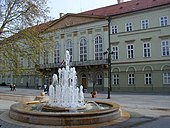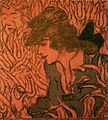József Rippl-Rónai


József Rippl-Rónai (born May 23, 1861 in Kaposvár , Austrian Empire ; died November 25, 1927 in Kaposvár, Kingdom of Hungary ) was a Hungarian painter of Symbolism and Late Impressionism and a pioneer of modernism in Hungarian painting.
Life
After graduating from high school , Rippl-Rónai first studied pharmacy in Budapest . In 1884 he went to Munich in order to attend the Academy at Johann Caspar Herterich and Wilhelm von Diez the academic painting to study won a scholarship and was able, two years later go to Paris there with Munkácsy to work. In his house he met the Scots James Pitcairn-Knowles , with whom he would be a lifelong friend. In 1889 he stayed in Pont-Aven and broke away from Munkácsy. He had his first solo exhibition in 1892 in the Austro-Hungarian embassy in Paris.
His first great success was the exhibition of the picture My Grandmother in 1894 at a Salon de Champ-de-Mars , which brought him acceptance and acceptance by the artist group Nabis , making him a “Nabi hongrois” . In 1899 he was Aristide Maillol's guest in Banyuls-sur-Mer for a long time, where he painted landscapes, seascapes and his host.
In his various artistic phases - after the symbolist, color-reduced, “black” period, four more are defined - it was always about not adapting to a group or school, but rather developing his own style and cultivating this difference. His goal was to become a great artist, which he could only achieve with originality.
He not only painted, but, like his colleagues, also devoted himself to applied art and designed everyday objects. The embroidery designed by him and executed by his French partner and later wife Lazarine Boudrion won a prize at the Paris World Exhibition. His Hungarian patron Andrássy commissioned him to furnish living spaces, works that were carried out by the artists Miksa Róth , Endre Thék and Vilmos Zsolnay . In 1912 he received an order for glass windows in the new building of the Ernst Museum, also in Budapest, where he was now staying again; the design was also shown in 1912 at the Sonderbund exhibition in Cologne . The glass objects he designed were created in collaboration with the glassblower Friedrich Zitzmann in Wiesbaden .
He taught at the free art school in Budapest, among others Sándor Bortnyik and István Beöthy , but he was unable to establish his own “school” in Hungary. He only gained recognition in his home country with difficulty and in stages. When he died in 1927 in the property he designed, the Villa Roma in Kaposvár, he was a Hungarian who had been in Paris and who had returned from the "West" ("Nyugat") to the circle of authors of the Nyugat , which he had portrayed in pastel pictures .
The baroque house and studio redesigned by Rippl-Rónai is set up as a museum, and paintings from his brother Ödön's collection hang on the walls.
His hometown has named the regional museum after him, which has large holdings of his work.
Autobiography
- Emlekezesei , Nyugat Budapest 1911, (Memoirs, Hungarian)
Works (selection)
literature
- K. Benda: Rippl-Rónai József. In: Austrian Biographical Lexicon 1815–1950 (ÖBL). Volume 9, Verlag der Österreichischen Akademie der Wissenschaften, Vienna 1988, ISBN 3-7001-1483-4 , p. 174.
- Károly Lyka : Rippl-Rónai, József . In: Hans Vollmer (Hrsg.): General lexicon of fine artists from antiquity to the present . Founded by Ulrich Thieme and Felix Becker . tape 28 : Ramsden-Rosa . EA Seemann, Leipzig 1934, p. 376 .
- A Hungarian in Paris: József Rippl-Rónai 1861 - 1927 ; Schirn Kunsthalle Frankfurt , October 2 to November 21, 1999 / [catalog ed. and red. by Anna Javór and Bettina-Martine Wolter. Übers. Essays: Terézia Mora ...], Heidelberg: Umschau / Braus 1999, ISBN 3-8295-7016-3
Web links
- Literature by and about József Rippl-Rónai in the catalog of the German National Library
- Fine Arts in Hungary
- Ilona Sármány – Parsons, The summer of our content , in: Budapesti Könyvszemle — BUKSZ, Winter 1998, pp. 382–389 BUKSZ
- Elfriede_Wiltschnigg: József Rippl-Rónai - the "Nabis hongrois" - and European symbolism (PDF file; 166 kB)
Individual evidence
- ↑ Ilona Sármány – Parsons, The summer of our content , counts five such phases
- ↑ Ilona Sármány – Parsons, ibid.
- ↑ on the Ernst Museum see Hungarian Wikipedia hu: Ernst Múzeum
- ^ Triptych draft for a colored window, Sonderbund, catalog # 323
- ↑ Ildikó Kálosi, Diána Radványi: Artists, studios and factories . In: Gabriella Balla, translated by Alan Campbell (ed.): Tiffany & Gallé - Art nouveau glass (catalog) . Museum of Applied Arts, Budapest 2007, ISBN 978-963-9738-03-4 , p. 136 ff .
- ^ Obituary in "Nyugat", volume 1, 1928 by Károly Kernstok (online in the Nyugat archive )
| personal data | |
|---|---|
| SURNAME | Rippl-Rónai, József |
| BRIEF DESCRIPTION | Hungarian painter |
| DATE OF BIRTH | May 23, 1861 |
| PLACE OF BIRTH | Kaposvár |
| DATE OF DEATH | November 25, 1927 |
| Place of death | Kaposvár |











